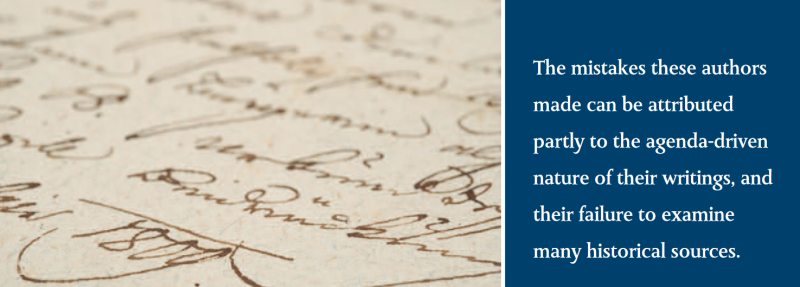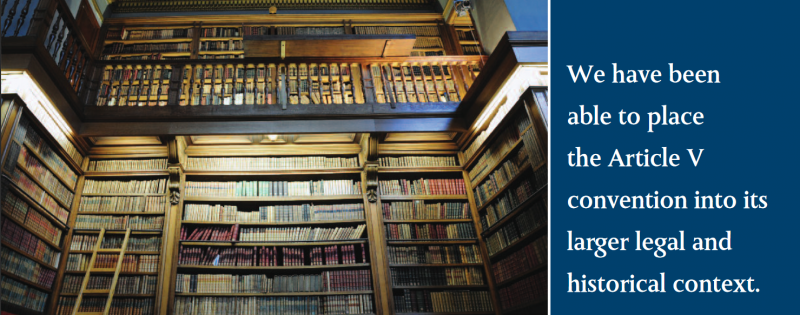Article 5 - How we have learned more and more about the Constitution’s “Convention for Proposing Amendments”
How We Have Learned More and More About the Constitution’s “Convention for Proposing Amendments”
Robert Natelson, Independence Institute’s Senior Fellow in Constitutional Jurisprudence and Head of the Institute’s Article V Information Center
This past week, conservative icon Phyllis Schlafly contributed a short piece to Townhall.com, in which she attacked the movement for an Article V convention. As I wrote in my response, she was relying on claims about the convention that had been superseded by modern research.
You can classify modern Article V writing in three broad waves. (There are many exceptions, but the generalization is valid, I think.) The first wave consisted of publications from the 1960s and 1970s, mostly — but not exclusively—by liberal academics who opposed conservative efforts to trigger a convention. Examples include articles by Yale’s Charles Black, William and Mary’s William Swindler, Duke’s Walter Dellinger, and Harvard’s Lawrence Tribe.
Typically, these authors concluded that an Article V “constitutional convention” (as they called it) could not be limited to a single subject. That, as we now know, was a mistake. A related error was their assumption that, when the Founders referred to a “general” convention, they meant a convention with unlimited subject matter. Actually, a “general convention” meant one in which all the states, or at least states from all regions, participated. It was the opposite of a “partial” or regional convention, and it had nothing to do with the scope of the subject matter.
The mistakes these authors made can be attributed partly to the agenda-driven nature of their writings, and their failure to examine many historical sources. They seldom ventured beyond The Federalist Papers and a few pages from the transcript of the 1787 Constitutional Convention.
Also in the First Wave was a 1973 study sponsored by the American Bar Association. The ABA document did conclude that a “constitutional convention” could be limited, but it was not a very solid piece of research, perhaps because (if my information is accurate) the principal writers were not professional scholars, but a pair of law students.
The Second Wave began in 1979 with a publication issued by President Carter’s U.S. Office of Legal Counsel and written by attorney John Harmon. For its time, it was a particularly thorough job. Among the other authors in this wave were Grover Rees III and the University of Minnesota’s Michael Stokes Paulsen. The most elaborate publication of this era was by Russell Caplan, whose book, Constitutional Brinksmanship, was released by Oxford University Press in 1988.
Second Wave authors accessed far more material than their predecessors. They paid more attention to the 1787–90 ratification debates. Caplan even made some reference to earlier interstate conventions. Most of them (Paulsen was an exception) correctly concluded that an Article V gathering could be limited.
But Second Wave writers did make some mistakes. They continued to refer to an Article V conclave as a “constitutional convention.” Some of them assumed, as some First Wave writers had, that Congress had broad authority under the Necessary and Proper Clause to regulate the convention and the selection and apportionment of delegates. None investigated the records of other interstate conventions in detail, or fully grasped their significance.
The Third Wave began in the 21st century. Its contributing authors include the University of San Diego’s Michael Rappaport, former House of Representatives Senior Counsel Mike Stern, the Goldwater Institute’s Nick Dranias, and myself. We have been able to place the Article V convention into its larger legal and historical context.
Like most of the Second Wave writers, we understand that an Article V convention can be limited. But we also have learned a lot of other things: The gathering is not a constitutional convention, it was modeled after a long tradition of limited-purpose gatherings, and it is governed by a rich history of practice and case law.
We also know that the Necessary and Proper Clause does not apply to conventions. That clause gives Congress power to make laws to carry into execution certain enumerated powers and “all other Powers vested by this Constitution in the Government of the United States, or in any Department or Officer thereof.” But a convention for proposing amendments is not part of the “Government of the United States,” nor is it a “Department or Officer thereof.” Supreme Court precedent, as well as the wording of the Constitution, make this clear. For this and other reasons, congressional powers over the process are quite limited.
A few days ago, a friend sent me a 1987 report issued by the U.S. Justice Department. The title is “Limited Constitutional Conventions Under Article V of the United States Constitution.” As the date would suggest, this is a typical Second Wave publication. In addition to labeling an Article V Convention as a “constitutional convention,” it also assumes that a “general” convention is one that is unlimited as to subject matter. It shows no familiarity with any previous1787interstate conventions other than the gathering. It makes the erroneous assumption that the latter meeting was called by Congress under the Articles of Confederation. It fails to under-stand the nature of the convention as a meeting of commissioners from state legislatures. It asserts erroneously that all 19th century state applications were for an unlimited convention. (In fact, several were limited.) And it makes the inaccurate assumption that Congress has power under the Necessary and Proper Clause to prescribe procedures for an amendments convention.
Such documents are of historical interest, but they should no longer be taken as authoritative.



